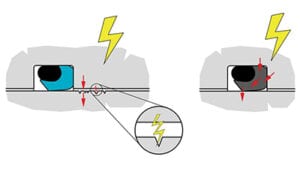Conductive sealing materials for dynamic applications
 Launched last year, Turcon MC1 and Turcon MC2 materials are said to be the only polytetrafluoroethylene (PTFE) based electrically conductive materials suited for use in spring and elastomer-energized seals. “Engineered for dynamic applications, seals and bearings from the materials will provide reliable electric connection between moving parts,” says Soeren Roepstorff, development manager at the company’s manufacturing facility in Helsingør, Denmark, where the new compounds were developed. “Conductive elastomers are available, but these are primarily only for static applications, while the conductive, injection-moldable plastic materials that exist have low flexibility and are less suited for sealing purposes and for installation in closed grooves,” he says. Electric charge transfer through the gap between two components can cause sparks or stray current in machinery and systems, for example in electric motors. This can result in hardware pitting and carbonization of lubricant or grease. Use of an electrically conductive seal or bearing grounds the system by creating a clear path between two components, avoiding corrosion issues. Turcon MC1 (photo, left) is a medium-filled material for dynamic applications requiring medium to high conductivity, while Turcon MC2 (photo, right) is a high-filled material for dynamic applications requiring high conductivity. — Trelleborg Sealing Solutions Americas, Schaumburg, Ill.
Launched last year, Turcon MC1 and Turcon MC2 materials are said to be the only polytetrafluoroethylene (PTFE) based electrically conductive materials suited for use in spring and elastomer-energized seals. “Engineered for dynamic applications, seals and bearings from the materials will provide reliable electric connection between moving parts,” says Soeren Roepstorff, development manager at the company’s manufacturing facility in Helsingør, Denmark, where the new compounds were developed. “Conductive elastomers are available, but these are primarily only for static applications, while the conductive, injection-moldable plastic materials that exist have low flexibility and are less suited for sealing purposes and for installation in closed grooves,” he says. Electric charge transfer through the gap between two components can cause sparks or stray current in machinery and systems, for example in electric motors. This can result in hardware pitting and carbonization of lubricant or grease. Use of an electrically conductive seal or bearing grounds the system by creating a clear path between two components, avoiding corrosion issues. Turcon MC1 (photo, left) is a medium-filled material for dynamic applications requiring medium to high conductivity, while Turcon MC2 (photo, right) is a high-filled material for dynamic applications requiring high conductivity. — Trelleborg Sealing Solutions Americas, Schaumburg, Ill.